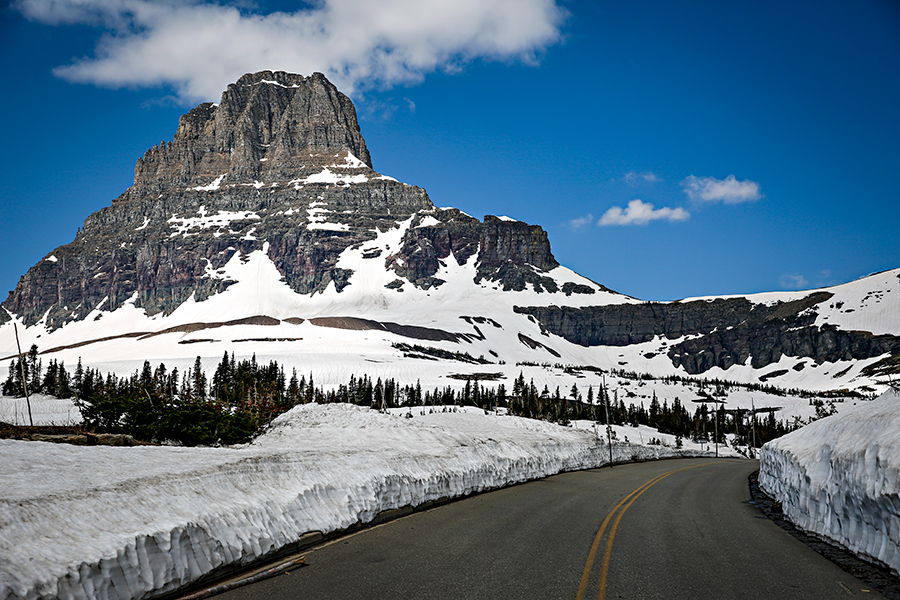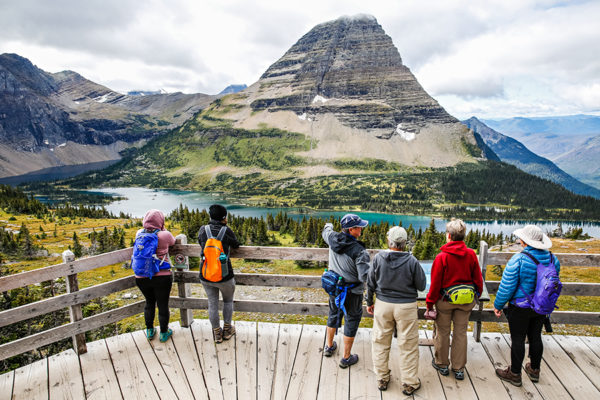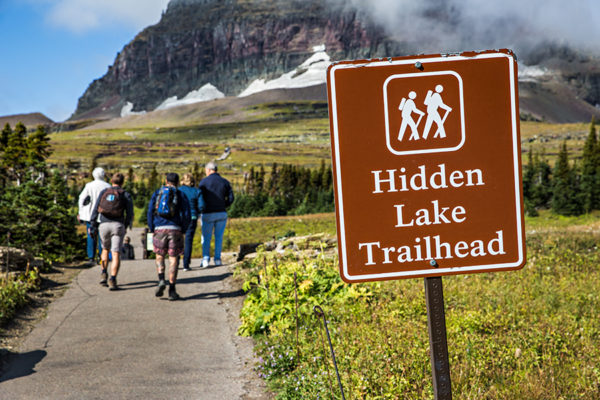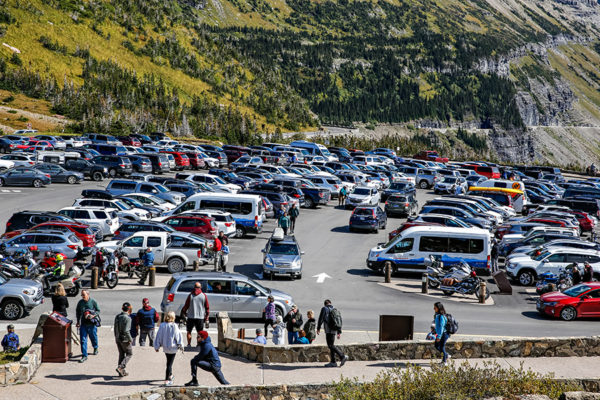The Road to Reopening
Concerns for health of staff, gateway communities, seasonal workers and visitors are complicating the reopening of national parks shuttered due to the coronavirus pandemic
By Tristan Scott
As superintendent of Glacier National Park, Jeff Mow has grappled with wildfires and wayward bears, flash floods and fatal avalanches. He’s tangled with budget deficits and government shutdowns, climate change and record-setting throngs of visitors that stretch the park’s infrastructure to maximum capacity.
He’s modeled scenarios that account for rising temperatures and shrinking glaciers, endangered species and invasive ones, trailheads choked with hikers, the strategic placement of a vault toilet, and the logistics of maintaining a 50-mile expanse of alpine highway that has to accommodate around 3 million people every year.
Until now, however, he’s never had to contend with a pandemic.
“This is a first,” Mow said. “But we do have some experience dealing with dynamic circumstances at Glacier National Park.”
Managing a million-acre unit of the National Park Service is, after all, a job that demands a high degree of administrative acrobatics, particularly when its accessibility is inextricably linked to the economies of its gateway communities, which are a destination due in large part to their proximity to Glacier.
As it turns out, a public-health crisis of this magnitude dwarfs blazes and bears and budgetary woes — or, rather, it lumps them all into one confusing ball of string.
Untangling that ball, and parsing one end from the other, has been Mow’s primary focus since March 27, when the park closed to visitors until further notice as cases of COVID-19 crept steadily upward in Montana, where state and local governments responded by introducing measures to slow the spread of coronavirus. Just like in most parts of the country, organizers canceled events, bars and restaurants closed, and people began adjusting to the counterintuitive practice of social distancing and sheltering in place.

At Glacier Park, not only have visitor services come to a grinding halt, but park-goers are prohibited from accessing any amenities beyond the barricades, including the Going-to-the-Sun Road (most of which remains buried in a winter’s worth of snow), the walking paths of Apgar Village and the peak-studded views of Lake McDonald.
In April, such restrictions might amount to nothing more than a disappointing loss of shoulder-season recreation for locals and enterprising visitors hoping to beat the crowds; but come June, when the Going-to-the-Sun Road typically opens, such a closure is like coring the region’s economic apple while depriving hundreds of thousands of people the opportunity to visit one of the National Park Service’s crown jewels.
Last year, Glacier National Park hosted 35,000 visitors in April, but by June, July and August those numbers brushed up against 1 million monthly visits as people poured into the park’s entrances from across the globe.
Preparations for those crowds are laid in January and February, when a seasonal workforce of more than 300 park employees is assembled, not including the 1,200-plus workers from around the world hired by private concessionaires like Xanterra Parks and Resorts and Glacier Park Collection by Pursuit to staff restaurants and gift shops.
In the context of the coronavirus pandemic, all of those moving pieces have been frozen in place.
“In some respects it’s not unlike past government shutdowns, so what goes on in the park are limited to those mission-critical needs — a certain amount of rangers for enforcement, water and sewer plant operators, crews plowing the roads,” Mow said. “But typically, we’d be gearing up to bring on 300 seasonal employees from all over the country, workers that we would house and feed for the summer. And that’s just not happening.”
Currently, more than 150 of the 419 units of the National Park System are closed or not offering visitor services, with a skeleton crew of employees performing “mission-essential” functions at Glacier Park, from law enforcement to maintenance of critical infrastructure.
Overarching concerns for the health of staff, gateway communities, concession workers, and visitors are complicating the reopening of national park sites across the country, with places like Glacier and Yellowstone facing some of the largest barriers given their popularity. Determining when individual parks will reopen hinges on numerous factors, all of them complicated by social-distancing requirements and the availability of personal protective equipment and adequate housing, with each unit operating under unique circumstances. Some parks have announced they’ll be closed into late June, while others are contemplating a staggered opening before summer arrives in earnest.
“What does social distancing look like in two weeks? We don’t know,” Mow said. “But we do know that, just like at colleges and universities, we should not be housing people from across the country together in dorms right now. And the park service as a whole shouldn’t be bringing on a lot of seasonal employees to gear up for a busy summer tourism season. So we are maintaining our current posture.”

Indeed, bringing workers on board from across the globe and housing them in dormitory settings is a potentially deadly proposition, about which the National Park Service’s public health director recently warned the agency’s deputy director, David Vela.
“We cannot predict the exact burden of disease that our workforce and parks will see as the COVID-19 pandemic runs its course, but we can say with absolute certainty that leaving our parks open to the public when social distancing is not being practiced, onboarding employees originating from throughout the country and world, and permitting significant shared housing environments will result in a significantly greater burden of disease and death than if we had taken the proactive measure to continue to close these parks and/or limit operations,” Capt. Sara Newman wrote in a memo to her deputy director on April 3, a copy of which was obtained by Sierra Magazine.
Issues that park staff are tackling now involve not only how to house employees to lessen the chance they might spread the disease, but in some states how to house employees that must self-quarantine for 14 days.
In her letter, Newman recommended that park managers “restrict new employees, volunteers, partners, and concessioners from coming into the park to the greatest extent possible because of the risk they present in transmitting disease,” stop dormitory housing for the time being, and restrict “park access in communities where there are stay-at-home orders where large numbers of visitors travel distances to visit parks and mitigation measures to maintain social distancing are not able to be enforced.”
On April 5, Vela issued a memorandum limiting seasonal hires to essential workers such as law enforcement, fire, maintenance, and custodial staff through May 24. According to the memo, the use of shared housing for these workers must align with guidance from U.S. public health officials. But the memo also notes that parks must be prepared to quarantine employees who test positive for the coronavirus and who may live in shared housing arrangements.
To juggle those workforces with available housing, some parks are planning to bring seasonal workers on in waves — a process called “onboarding” — with the first expected to arrive sometime in May.
Mow is considering seasonal onboarding at Glacier Park, but planning with any degree of certainty is impossible given the unknowns about the future, especially relating to how the park effectively mitigates transmission risks to its employees on the front-lines and manages large congregations of visitors, as well as visitors in lodges and employees in dormitories.
“We’re not going to rush into this without working closely with state, county and tribal public health officials, as well as other stakeholders. We have to make sure that what we are doing doesn’t pose a risk to the community,” Mow said. “It will probably very much have a phased-in approach, and we’re going to do what we can to connect people to this important resource. But I’m not going to set the expectation that we could open next week. There is too much uncertainty for that.”
Mow said he’s applying lessons learned from Glacier’s recent wildfire seasons to the current situation, including the 2018 Howe Ridge Fire that closed vast sections of the park to visitors, but eventually reopened.
“We do have some experience at Glacier National Park with major disruptions, and we found ways to open things back up gradually,” Mow said. “We will take a lot of the lessons we learned from those fires and from the government shutdowns, and we will apply those experiences to COVID-19. But that still doesn’t give us a reliable forecast of when it might be appropriate to open again.”
It was difficult enough to determine when it was appropriate to close.
Gov. Steve Bullock requested the immediate, temporary closure of Glacier National Park on March 24, three days before the closure went into effect. At the time, Montana had 109 cases of COVID-19, a figure that has since quadrupled. Since the influx of new cases has slowed, Bullock announced that the state plans to begin a phased reopening of its economy following the April 24 expiration of the stay-at-home order and other directives.
But the decision to close Glacier did not ultimately come at Bullock’s behest — it was made by the Department of Interior, which one week earlier announced the National Park Service was suspending all entrance fees until further notice, a step Interior Secretary David Bernhardt said at the time “makes it a little easier for the American public to enjoy the outdoors.”
The decision one week later to begin closing popular national parks was a confusing about-face for the public to digest, particularly as Montanans began retreating to open spaces and public lands in droves.
The uptick in outdoor-related activities has created concerns for many national parks located in the most isolated and least medically equipped areas of the country, where an uptick in visitation would only add to the strain on an already overburdened health care system, advocates of temporary closures say, as well as a greater workload for emergency services personnel and first responders in gateway communities.
The Interior Department’s piecemeal approach to closing some parks — many of them only after local officials exposed the dangers of keeping them open — and leaving others open has delayed a uniform response by parks to the pandemic.
Given Glacier National Park’s unique suite of circumstances, it’s important to have management flexibility, Mow said, even though he acknowledged that the park might have been contributing to the spread of coronavirus up until its closure.
“When we had those warm days and received a lot of visitors, Glacier National Park was part of the problem of the pandemic,” Mow said. “But when we turn the corner, the park will also be very fundamental to the economic recovery. So I have to be able to be very nimble in how I position myself to be able to turn on a dime and go from being closed to open with all of the social distancing requirements in place.”

With limited staff, the park can only do so much to accommodate a rush of visitors, but one segment of its staff that remains in place is the plow crews working to clear the Sun Road. The heavy machinery used to clear the dozens of avalanches that bury the road every winter require some snow to operate effectively and avoid damaging the asphalt, so the spring plows are on schedule.
“Having the Going-to-the-Sun Road open might be the one thing we’re capable of doing,” Mow said. “It may be limited, and it may be that not all the trails are open, but having that road open is probably the single most important thing in terms of economic recovery that we at the National Park Service could be doing locally.”
“I’m not saying that visitors will be sealed in their cars all summer long,” Mow said. “But it may have to start out as a very, very basic visit to Glacier National Park.”